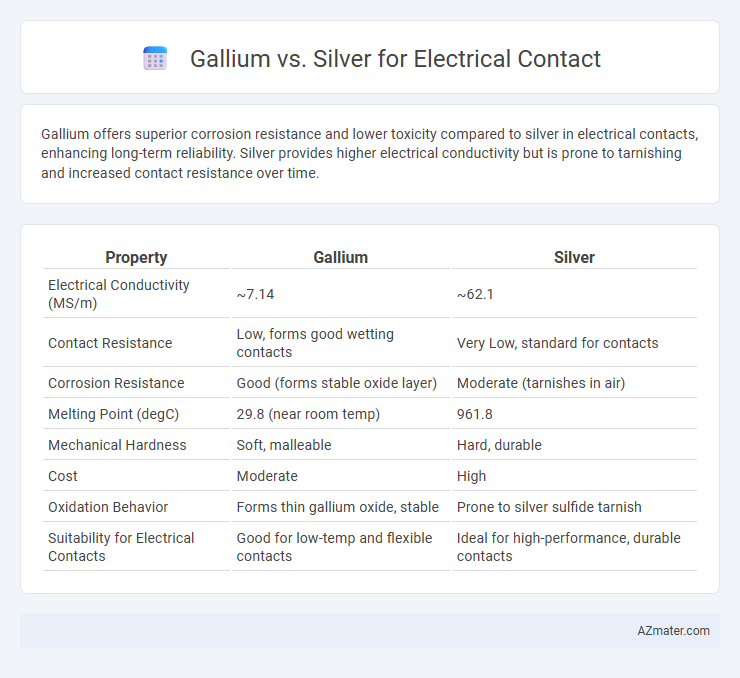Gallium offers superior corrosion resistance and lower toxicity compared to silver in electrical contacts, enhancing long-term reliability. Silver provides higher electrical conductivity but is prone to tarnishing and increased contact resistance over time.
Table of Comparison
| Property | Gallium | Silver |
|---|---|---|
| Electrical Conductivity (MS/m) | ~7.14 | ~62.1 |
| Contact Resistance | Low, forms good wetting contacts | Very Low, standard for contacts |
| Corrosion Resistance | Good (forms stable oxide layer) | Moderate (tarnishes in air) |
| Melting Point (degC) | 29.8 (near room temp) | 961.8 |
| Mechanical Hardness | Soft, malleable | Hard, durable |
| Cost | Moderate | High |
| Oxidation Behavior | Forms thin gallium oxide, stable | Prone to silver sulfide tarnish |
| Suitability for Electrical Contacts | Good for low-temp and flexible contacts | Ideal for high-performance, durable contacts |
Introduction to Gallium and Silver in Electrical Contacts
Gallium and silver are widely used materials for electrical contacts due to their excellent conductivity and unique properties. Silver offers the highest electrical conductivity among metals, making it a preferred choice for low-resistance connections, while gallium is valued for its liquid state near room temperature, enabling flexible and self-healing contact interfaces. Understanding the distinct physical and chemical characteristics of gallium and silver helps optimize their applications in electrical circuits and devices requiring reliable contact performance.
Electrical Conductivity Comparison
Gallium exhibits lower electrical conductivity than silver, with silver having one of the highest conductivities among metals at approximately 63 x 10^6 S/m, while gallium's conductivity is around 7.3 x 10^6 S/m. The superior conductivity of silver makes it the preferred choice for electrical contacts requiring minimal resistance and efficient current flow. However, gallium's unique liquid state near room temperature offers alternative applications despite its lower conductivity.
Thermal Properties and Performance
Gallium exhibits a melting point of approximately 29.76degC, allowing it to form low-resistance, conformal contacts in electrical applications, while silver, with a melting point of 961.8degC, maintains robust thermal stability under high-temperature conditions. Gallium's thermal conductivity is about 29 W/m*K, significantly lower than silver's exceptional 429 W/m*K, influencing heat dissipation efficiency in electrical contacts. Silver's superior thermal performance ensures minimal temperature rise and enhanced reliability, whereas gallium's unique low-melting characteristic facilitates self-healing contacts but limits its use in high-temperature environments.
Corrosion Resistance and Longevity
Gallium exhibits superior corrosion resistance compared to silver, as it forms a stable oxide layer that protects electrical contacts from degradation in harsh environments. Silver, while highly conductive, is prone to tarnishing and corrosion due to sulfide formation, which reduces its longevity in electrical applications. Consequently, gallium-enhanced contacts offer extended operational life and improved reliability in corrosive or high-humidity conditions.
Mechanical Strength and Durability
Gallium exhibits lower mechanical strength compared to silver, making it less resistant to deformation under mechanical stress in electrical contact applications. Silver's superior hardness and tensile strength enhance its durability, providing reliable performance and longer lifespan in high-load electrical contacts. The durability of silver contacts ensures better maintenance of conductivity over repeated cycles, whereas gallium may suffer from quicker wear and fatigue.
Cost Analysis: Gallium vs Silver
Gallium offers a cost-effective alternative to silver for electrical contacts due to its lower raw material price and abundance, significantly reducing initial expenses. While silver boasts superior conductivity, its high market cost and price volatility make it less economically viable for large-scale applications. Gallium's affordability combined with acceptable electrical performance positions it as a strategic choice in cost-sensitive electrical contact manufacturing.
Environmental Impact and Sustainability
Gallium offers a lower environmental footprint compared to silver due to its greater abundance and less intensive mining process, reducing habitat disruption and resource depletion. Silver mining generates significant waste and often involves toxic chemicals like cyanide, raising concerns over soil and water contamination. Gallium's recyclability and reduced reliance on scarce resources make it a more sustainable choice for electrical contacts in green technology applications.
Applications in Modern Electronics
Gallium offers superior corrosion resistance and low melting point, making it ideal for sensitive or flexible electronic contacts, whereas silver excels in electrical conductivity and durability for high-performance connectors in power electronics. In modern electronics, gallium-based contacts are commonly used in microelectromechanical systems (MEMS) and flexible circuits, while silver remains the preferred material for printed circuit boards (PCBs), switches, and high-frequency applications. The choice between gallium and silver depends on the specific requirements of conductivity, mechanical stress tolerance, and environmental stability in advanced electronic devices.
Challenges in Manufacturing and Usage
Gallium presents challenges in electrical contact manufacturing due to its low melting point of 29.76degC, causing potential material deformation and stability issues under standard operating temperatures. Silver, though possessing excellent conductivity and resistance to oxidation, faces difficulties such as high costs and susceptibility to tarnishing, which can degrade contact performance over time. Both materials require specialized handling and protective coatings to ensure reliable long-term usage in electrical contacts.
Future Trends and Innovations
Gallium is emerging as a promising alternative to silver for electrical contacts due to its superior corrosion resistance and ability to form low-resistance, self-healing interfaces, which are critical for next-generation flexible and wearable electronics. Innovations in gallium-based composites and gallium alloy coatings are enabling enhanced conductivity and durability while addressing silver's limitations such as cost and susceptibility to tarnishing. Future trends indicate increased adoption of gallium in electric vehicles, renewable energy systems, and miniaturized devices where reliable, long-lasting electrical contacts are essential.

Infographic: Gallium vs Silver for Electrical Contact
 azmater.com
azmater.com